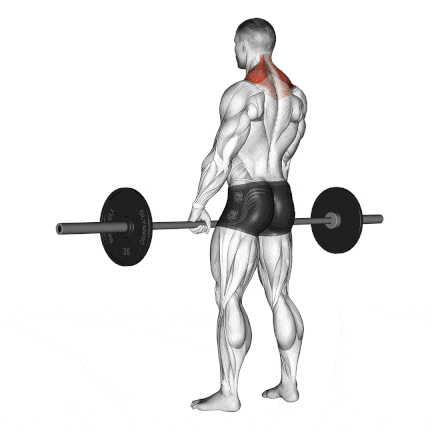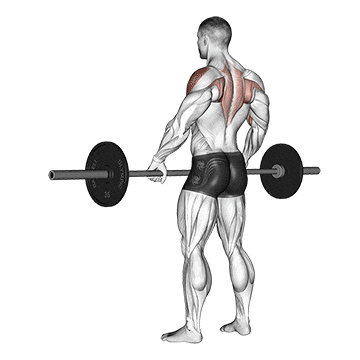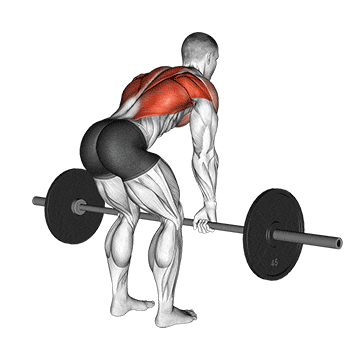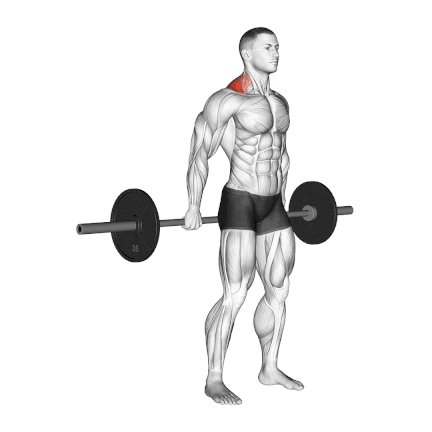Ready to build a head-turning, boulder-like set of traps? Look no further. In this guide, I’m sharing my 7 favorite (based on science and experience) barbell trap exercises that will pack on serious mass and strength.
The exercises have been chosen because they can work the traps from different angles and give the trap muscles a good workout.
The trapezius, aka trap muscle, is a large muscle in your back. Its shape is like a trapezoid (a shape with four sides, two of which are parallel).
As mentioned above, the trapezius muscle is divided into 3 areas:

Although every barbell trap exercise hits all three muscle fibers to some degree, some exercises are better than others at training the different muscle fibers due to the biomechanics involved.
Let’s get started!

- 7 Best Barbell Trap Exercises
- 1. Barbell Shrug
- 2. Barbell Upright Row
- 3. Deadlift
- 4. Bent Over Barbell Row
- 5. Bent Over Barbell Rear Delt Row
- 6. Behind-the-Back Barbell Shrug
- 7. Barbell Overhead Carry
- How To Add Barbell Trap Exercises In Your Workout Routine
- 1. Back Workout Routine
- 2. Pull Workout Routine
- FAQs
- How To Get Bigger Traps With Barbell
- Is it OK to train traps everyday?
- What exercise makes traps bigger?
7 Best Barbell Trap Exercises
Adding barbell trap exercises to your workout routine is a good idea.
1. Barbell Shrug
The shrug is one of the simplest and easiest trap exercises to perform. You can do the shrug using a dumbbell, barbell, or Smith machine, but the barbell variation is the classic one to build massive traps.
The Barbell Shrug is one of the best exercises for building bigger and stronger trap muscles. This trap-specific exercise can be done extremely heavily, which will help you strengthen your traps for back poses.
It is one of the best isolation exercises for the trapezius muscle, especially the upper trap.
A study has shown that shrugging helps relieve shoulder and neck pain. Strengthening your traps helps provide better support to your head and neck by increasing the activation of your shoulder muscles. It helps to improve grip strength and forearm development.

How To Do
- Stand with feet placed shoulder-width apart, knee slightly bent, and core stable.
- Grip the barbell with your hands facing downwards in a pronated grip.
- Raise your shoulders without bending the elbows as far as possible, getting them closer to your ears.
- Hold the contraction and squeeze for a brief second.
- In a controlled and stable manner, lower the weight back to the starting position.
Tips
- Go as high as possible, but limit momentum and excessive jerking or bouncing of the weight.
- Go full range. Move only the shoulders and keep the rest of the body steady.
- Your hands should be slightly wider than shoulder-width.
- The bar should move in a straight line upwards and downwards, so don’t roll your shoulders.
2. Barbell Upright Row
The upright row effectively targets the posterior chain muscles, including the shoulders, upper back, and trap muscles. It’s a pull exercise that involves pulling the weight towards you and working the muscles on the back side of your body.
You can perform upright rows using a Smith machine, free weights, or a cable. The barbell upright row is one of the best variations of upright row for building bigger, stronger middle and lower trap muscles.
There are different ways to do the barbell upright row. It depends on how you hold the barbell.
Barbell upright rows can be performed with three main variations of grip width:
- The close or narrow grip (half of shoulder width): focuses more on the trapezius. (Be cautious with it, as it can cause shoulder impingement)
- A standard grip (shoulder-width grip): focuses on the entire shoulder girdle.
- A wide grip (wider than the shoulder): allows some cheating movement, allowing you to lift more weight. (Best option for beginner)

How To Do
- Stand up straight with your feet about hip-width apart.
- Hold a barbell with an overhand grip (palms facing your body).
- Your hands should be about shoulder-width apart or slightly narrower.
- Let the barbell hang in front of your thighs with your arms fully extended.
- Keep the barbell close to your body, exhale, and slowly lift it straight up towards your chin.
- Pause briefly at the top of the movement, then inhale and lower the barbell back down to the starting position.
Tips
- Don’t lift your arms all the way up. Instead, stop when your elbows are at or slightly below shoulder level.
- Focus on keeping your elbows higher than your forearms.
- Keep a controlled motion and avoid jerky movements.
- Start with an empty barbell or very light weights. Focus on mastering the movement pattern first.
3. Deadlift
The deadlift is the King of all exercises—this power exercise is designed to build an overall physique that uses more muscles than any other exercise.
The deadlift engages virtually every major muscle group in your body.
It is the best exercise for posterior chain muscle strengthening. It works on your whole body, including the upper back, lower back, upper back, arms, legs, and buttocks.

How To Do
- Place a barbell loaded with weights in front of you.
- Grab the barbell using an underhand grip with one hand and an overhand grip with the other hand.
- Remember to keep your back as straight as possible and contract your back and hamstrings.
- Now raise the bar from the ground using your hamstrings and glutes.
- You should keep your legs slightly bent, your back straight, and your head looking up.
- Raise it to the point where your body is erect. Do not hyperextend your body as the weight shifts to the lumbar spine.
- Hold the bar momentarily at the top of the lift and remember to lock out.
- Slowly lower the bar steadily by bending at the hips first and then at the knees.
- Allow the weight to almost touch the ground for a moment before beginning the next rep.
Tips
- Never compromise on form to lift heavier weights; this could lead to serious injury.
- Lower back muscles take a long time to recuperate; hence, heavy deadlifts will do the job once a week.
- Go full range of motion and keep form correct. Avoid jerky movements and keep them controlled.
- The stability of flat-soled shoes or lifting barefoot can be better than that of cushioned running shoes.
4. Bent Over Barbell Row
This powerful move is about building a thick back and sculpting a V-taper that will turn heads and make you feel like a superhero. This exercise primarily targets the latissimus dorsi and also engages your traps, rhomboids, and rear deltoids.
Unlike traditional shrugs, the Bent Over Row hits your traps from a different angle. As you pull that barbell towards your abdomen, your traps work overtime to stabilize your shoulder blades.
This unique movement pattern doesn’t just target your middle and lower traps – it absolutely lights them up.

How To Do
- Hold a barbell with a pronated grip (palms facing down). Your feet should be shoulder-width apart.
- Bend your torso forward at an angle of 45 or lesser degrees to the floor with knees slightly bent and let the bar hang in front of you.
- Now, use the back and raise the bar until it touches the sternum region. Keep your elbows tucked in and close to the body.
- 4. Pause and hold at the top of the movement, squeezing your back muscles.
- Slowly lower the bar under control to the starting position.
Tips
- Do not use more weight than you can handle. This fatigues your spinal erectors and says goodbye to form.
- Exhale on pushing movement and inhale when returning to the starting position.
- Hold a neutral spine throughout the movement to prevent injury.
5. Bent Over Barbell Rear Delt Row
The bent-over barbell rear delt row and the normal bent-over barbell row may look similar at first, but they work different muscles.
During the delt row, you use a wider grip, often beyond shoulder width, and the bar is pulled towards the forehead or upper chest. It primarily targets the rear deltoid and trap, and to a lesser degree, it also targets the biceps and shoulders.
Keep the weight moderate and focus on form. It’s tempting to go heavy, but I’ve seen the best results by really concentrating on squeezing those rear delts at the top of each rep.

How To Do
- Stand up straight while holding a barbell using a wide (higher than shoulder width) and overhand (palms facing your body) grip.
- With slightly bent knees, bend over at the waist so that your chest is parallel to the floor.
- While keeping the upper arms perpendicular to the torso, pull the barbell up towards your upper chest as you squeeze the rear delt.
- Slowly go back to the initial position as you breathe in.
Tips
- Refrain from using your biceps to do the work. Focus on targeting the rear delts, the arms should only act as hooks.
- Focus on the form before you go for a heavyweight.
- Maintaining the right posture while working out is extremely important.
Know More: 12 Best Mid-Trap Exercises For Muscle Mass And Strength
6. Behind-the-Back Barbell Shrug
The barbell behind-the-back shrug is one of the best trap exercises for targeting the traps. Having the bar behind you helps keep your shoulders pulled up and back, rather than rounded forward.
It is popular in strength and muscle-focused upper-body training and is often trained on a shoulder day.

How To Do
- Stand while holding a barbell with an overhand grip behind your thighs. Both your hands and your feet should be shoulder-width apart.
- Lift your shoulders up toward your ears as high as possible while keeping your arms straight.
- Hold the contraction for a second before lowering the bar back to the starting position.
- Repeat for the desired number of repetitions.
Tips
- Focus on lifting the weight with your traps and not your biceps.
- Pausing at the top of the barbell shrug makes the exercise more challenging, and you’ll get more out of it.
- Do not roll your shoulders as this can lead to a shoulder injury.
Know More: Best Upper Trap Exercises For Muscle Mass and Strength
7. Barbell Overhead Carry
Don’t be deceived by its simplicity – the barbell overhead carry is a secret weapon for building bulletproof shoulders, a rock-solid core, and a posture that exudes confidence.
Your traps are under fire the entire time you’re holding that bar overhead. It’s like a never-ending shrug; believe me, your traps will be screaming (in a good way) by the end.
Your abs and lower back have to work overtime to keep you upright. It’s practically a full-body workout disguised as an upper-body exercise.

How To Do
- Load a barbell with a weight you can carry overhead. Grab the barbell with a wider than shoulder-width grip.
- Stand with your feet shoulder-width apart, toes pointed slightly outward.
- Use a clean and press or push press to lift the barbell overhead.
- Engage your core and glutes to stabilize your body. Keep your head neutral, gaze forward, and chin slightly tucked.
- Take small, controlled steps forward.
- Start with a shorter distance (10-20 meters) and gradually increase as you get stronger.
- Do 2–3 sets of the overhead carry, resting 1–2 minutes between sets.
Tips
- Avoid leaning forward or backward as you walk.
- Don’t forget to breathe. Inhale deeply through your nose and exhale slowly through your mouth.
- Keep your wrists straight and avoid bending them back.
- Do not fully lock out your elbows as this will stress the joint and may potentially be injurious.
How To Add Barbell Trap Exercises In Your Workout Routine
They can be incorporated into your workout routine in a variety of ways. Here are some options:
- As a standalone exercise: Do on 3-4 sets of 8-12 reps.
- As part of a back workout: Do 3-4 sets of 8-12 reps along with other bicep exercises like the Deadlift and lats pulldown.
- As part of a full-body workout: Do 3-4 sets of 8-12 reps along with other compound exercises like squats, deadlifts, and bench presses.
1. Back Workout Routine
| Exercise | Sets | Reps |
|---|---|---|
| Deadlift | 4 | 6-8 |
| Pull Ups | 3 | 10-12 |
| One Arm Dumbbell Row | 3 | 8-10 |
| Barbell Row | 4 | 8-12 |
| Barbell Upright Row | 3 | 8-12 |
2. Pull Workout Routine
| Exercise | Sets | Reps |
|---|---|---|
| Pull-Ups | 3 | 8-10 |
| Plank | 3 | 8-12 |
| Lats Pulldowns | 3 | 10-12 |
| Dumbbell Spider Curl | 3 | 8-12 |
| Barbell Shrugs | 3 | 8-12 |
FAQs
How To Get Bigger Traps With Barbell
There are many great trap exercises you can do with a barbell to help you build bigger traps.
You should add the abovementioned barbell exercises to your upper body training sessions to build bigger, stronger traps.
Barbell shrugs and barbell upright rows can be used to build up the upper traps, and pulling the shoulder blades together can be used to build up the middle and lower traps.
To build big trap muscles, you need an intensive workout routine, which typically consists of 2-3 exercises, including the upright row and shrugs.
You should perform this workout two times a week, with at least three days of rest between each workout.
Is it OK to train traps everyday?
No, it is not OK to train traps every day. Overtraining can lead to injuries and hinder progress. Resting for at least 48 hours between trap-focused workouts is usually recommended to let your muscles recover.
What exercise makes traps bigger?
Many exercises can help you build bigger traps, but some of the most effective include:
- Barbell Shrugs
- Dumbbell Shrugs
- Trap Bar Deadlifts
- Upright Rows
- Farmer’s Walks
- Face Pulls
- Y-raises
References
- Schoenfeld, Brad MSc, CSCS; Kolber, Morey J PT, PhD, CSCS; Haimes, Jonathan E BS, CSCS: The Upright Row: Implications for Preventing Subacromial Impingement. Strength and Conditioning Journal: October 2011 – Volume 33 – Issue 5 – p 25
- Cools AM, Witvrouw EE, Declercq GA, Danneels LA, Cambier DC. Scapular muscle recruitment patterns: Trapezius muscle latency with and without impingement symptoms. Am J Sports Med 31: 542–549, 2003.
- Int J Environ Res Public Health. Trapezius muscle timing during selected shoulder rehabilitation exercises. 2021 Jun 14;18(12):6444. doi: 10.3390/ijerph18126444.PMID: 34198674
- Effects of Lower Trapezius Strengthening Exercises on Pain, Dysfunction, Posture Alignment, Muscle Thickness and Contraction Rate in Patients with Neck Pain; Randomized Controlled Trial
- Selective recruitment of the lower fibers of the trapezius muscle.

Manish brings over 10 years of hands-on experience in weight lifting and fat loss to fitness coaching. He specializes in gym-based training and has a lot of knowledge about exercise, lifting technique, biomechanics, and more.
Through “Fit Life Regime,” he generously shares the insights he’s gained over a decade in the field. His goal is to equip others with the knowledge to start their own fitness journey.
